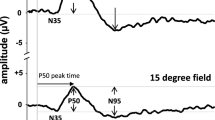Abstract
The pattern electroretinogram has assumed greater clinical and experimental significance because of its inner retinal origins. However, clinical tests may be confounded by an artifact. We tested subjects varying reference electrode position and eye stimulated while employing the Dawson-Trick-Litzkow (DTL) fiber electrode as the active electrode. The presence of a statistically significant artifactual response could not be confirmed. However, the variability of responses elicited with the outer canthus was less and the signal-to-noise ratio greater than with other reference positions.
Similar content being viewed by others
References
Arden, GB, Carter, RM, Hogg, C, Siegel, IM, Margolis, S (1979) A gold foil electrode: extending the horizons for clinical electroretinography. Invest Ophthalmol Vis Sci 18: 421–426
Arden, GB, Carter, RM, Hogg, C (1986) Uniocular recording of pattern ERG. Vision Res 26: 281–286
Berninger, T, Schuurmans, RP (1985) Spatial tuning of the pattern ERG across temporal frequency. Doc Ophthalmol 61: 17–25
Dawson, WW, Trick, GL, Litzkow, CA (1979) Improved electrode for electroretinography. Invest Ophthalmol Vis Sci 18: 988–991
Dawson, WW, Trick, GL, Maida, TM (1982) Evaluation of the DTL corneal electrode. Doc Ophthalmol Proc Series 31: 81–88
Fiorentini, A, Maffei, L, Pirchio, M, Spinelli, D, Porciatti, V (1981) The ERG in response to alternating gratings in patients with diseases of the peripheral visual pathway. Invest Ophthalmol Vis Sci 21: 490–493
Hobson, R, Odom, JV, Maida, TM, Dawson, WW (1984) Effects of reference electrode positions on the amplitude and variability of the pattern evoked retinal potential. Invest Ophthalmol Vis Sci 25 (Suppl): 64
Leguire, LE, Rogers, GL (1985) Pattern electroretinogram: use of noncorneal skin electrodes. Vision Res 25: 867–870
Odom, JV, Maida, TM, Dawson, WW (1982) Pattern evoked retinal response in human: effects of spatial frequency, temporal frequency, luminance and defocus. Curr Eye Res 2: 99–107
Odom, JV, Norcia, AM (1984) Retinal and cortical potentials: spatial and temporal characteristics. Doc Ophthalmol Proc Series 40: 29–38
Peachey, NS, Sokol, S, Moskowitz, A (1983) Recording the contralateral PERG: effect of different electrodes. Invest Ophthalmol Vis Sci 24: 1514–1516
Seiple, WH, Siegel, IM (1983) Recording the pattern electroretinogram: a cautionary note. Invest Ophthalmol Vis Sci 24: 796–798
Winer, BJ (1971) Statistical Principles in Experimental Design. New York: McGraw-Hill.
Author information
Authors and Affiliations
Rights and permissions
About this article
Cite this article
Odom, J.V., Maida, T.M., Dawson, W.W. et al. Pattern electroretinogram: Effects of reference electrode position. Doc Ophthalmol 65, 297–306 (1987). https://doi.org/10.1007/BF00149936
Issue Date:
DOI: https://doi.org/10.1007/BF00149936




